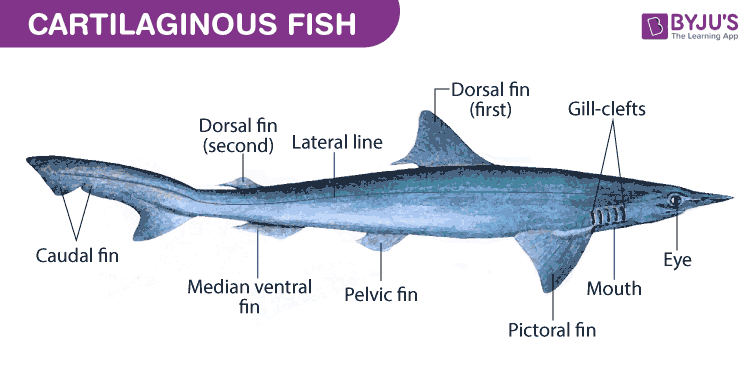Fish (Pisces) is a general term that refers to various aquatic craniate animals, including lampreys, hagfish, cartilaginous fishes, and bony fishes. Pisces is an obsolete superclass that can be classified into three classes –
- Placodermi – an extinct group of spiny sharks
- Chondrichthyes – Cartilaginous fishes
- Osteichthyes – Bony fishes
Cartilaginous fishes are fearsome predators and harmless mollusc-eaters belonging to the class Chondrichthyes. They are cold-blooded (poikilotherms) animals. Like most other fish, they also lack the system to regulate their internal body temperature. The skeleton of cartilaginous fishes is made up of cartilage. Only the teeth of this species and rarely the vertebrae are calcified. Sharks, skates, chimaeras and rays make up the group of Chondrichthyes.
Classification
|
Kingdom |
Animalia |
|
Phylum |
Chordata |
|
Subphylum |
Vertebrata |
|
Infraphylum |
Gnathostomata |
|
Class |
Chondrichthyes |
Labelled Diagram of Cartilaginous Fish

General Characteristics of Cartilaginous Fishes
- The cartilaginous fishes are jawed vertebrates mostly found in the marine environment.
- Their endoskeleton is cartilaginous with a tough outer skin except in electric rays, which have soft and loose skin.
- Placoid scales, or dermal denticles, are found in most cartilaginous fishes.
- In most cartilaginous fishes, the jaw suspension is amphistylic.
- Gills are the respiratory organs and they typically have 5-7 pairs of gills (varies with species).
- They do not have swim bladders or air-bladders.
- Their lateral line system (sense organs) detects water pressure, vibration and other motions surrounding them.
- The tail bears a heterocercal type of caudal fin.
- Males have reproductive organs called the clasper.
- Fertilisation is internal. They may be vivparous, ovoviviparous or oviparous.
- These are divided into two sub-classes – Elasmobranchii and Holocephali.
Also Check: Respiration in Fish: How Do Fish Breathe?
Elasmobranchii (Sharks, Skates and Rays)
- The upper jaw is not united with the cranium, but the lower jaw is articulated with the upper jaw.
- They typically have 5-7 pairs of gill slits on each side which are not covered by an operculum.
- Their skin is either naked or covered with minute placoid scales that are dermal in origin.
- A scroll valve or spiral valve is present in the intestine.
- They have broad and paired pelvic and pectoral fins.
- Claspers are present in the pelvic fin region of the males for the transmission of sperms.
- Some of them have the electric organ (Torpedo) and some have poison sting (Trygon).
- Some Elasmobranchii have Leydig’s organ that produces RBCs and have a role in the immune system.
Holocephali (Chimaeras)
- Notochord is intact in Holocephali.
- Their upper jaw is immovable and united with the cranium.
- Their skin is devoid of scales in the adults, except in the clasping organ. Also, some show a unique presence of frontal claspers.
- Their gill openings are protected by gill cover or opercula.
- Their mouth is small compared to the wide mouth of Elasmobranchii .
- They have a simplified gut with a fused stomach and intestine.
- They have a thin long tail and move by the flapping of large-sized pectoral fins. This is in contrast to the sharks that move by thrusting their heterocercal tail.
Cartilaginous vs Bony Fishes
As the name denotes, the endoskeleton of cartilaginous fishes are primarily made of cartilage and those of bony fishes are made of bones. The swim bladder is present in most bony fishes, while it is absent in cartilaginous fishes. The cartilaginous fishes maintain buoyancy with the help of oil that they secrete.
Examples of bony fishes – Tuna and Trout
Examples of cartilaginous fishes – Sharks and Electric rays
For more differences, explore: Difference between Bony Fish and Cartilaginous Fish

Keep exploring BYJU’S Biology for more such exciting diagram topics.
Comments